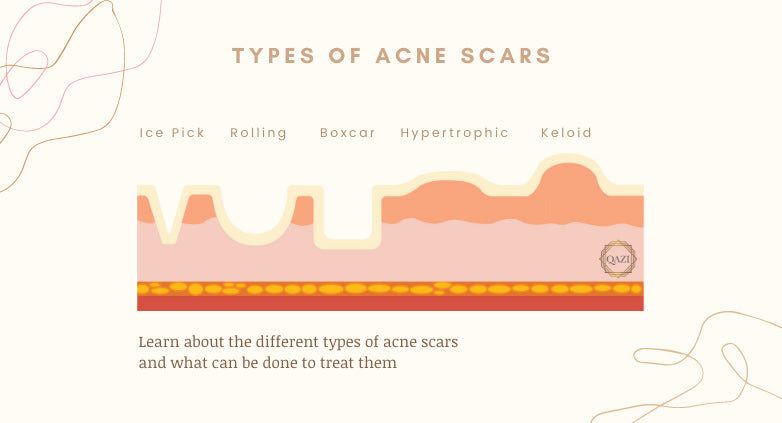While some acne scars fade over time, others can be permanent without proper treatment. Understanding the different types of acne scars is crucial in determining the best course of action for treatment. At Qazi Cosmetic Center, we specialize in personalized acne scar treatment plans tailored to your skin type and scar severity.
This guide will explore the different types of acne scars, their causes, and the most effective treatment options available today.

What Causes Acne Scars?
Acne scars form when deep inflammation damages the skin’s structure. The body attempts to repair this damage by producing collagen, but depending on how much or how little collagen is produced, different types of scars can develop. The main factors that influence acne scarring include:
- Severity of Acne: Cystic acne and inflammatory acne are more likely to cause scarring.
- Skin Type: Some skin types are more prone to post-inflammatory hyperpigmentation and scarring.
- Genetics: A family history of acne scars increases the likelihood of developing them.
- Delayed or Improper Treatment: Picking, popping, or squeezing acne lesions can worsen inflammation and lead to permanent scars.
Types of Acne Scars
Types of acne scars fall into two main categories: atrophic (depressed scars) and hypertrophic (raised scars). Each type has unique characteristics and requires different treatment approaches.
1. Ice Pick Scars
- Appearance: Deep, narrow scars that extend into the dermis, resembling tiny holes or punctures.
- Causes: Severe inflammatory acne, particularly cystic acne.
- Treatment Options:TCA Cross (Trichloroacetic Acid): Directly applied to the scar to stimulate collagen production.Punch Excision: Surgically removes individual scars, followed by suturing or grafting.Laser Resurfacing (CO2 or Erbium): Helps smooth the surrounding skin.
2. Boxcar Scars
- Appearance: Broad, shallow depressions with defined edges.
- Causes: Inflammatory acne that destroys collagen and leaves behind depressed marks.
- Treatment Options:Laser Resurfacing (Fractional CO2, Fully Ablative CO2, or Erbium): Improves skin texture.Subcision: Releases tethered scar tissue to allow skin to lift.Dermal Fillers (Bellafill, Sculptra, or Radiesse): Fills in depressions for a smoother surface.Punch Excision: Removes severe boxcar scars.
3. Rolling Scars
- Appearance: Wave-like depressions across the skin, often giving it an uneven texture.
- Causes: Fibrous bands beneath the skin pull the epidermis downward.
- Treatment Options:Subcision (Blunt Cannula, Nokor Needle, or Taylor Liberator): Breaks fibrous bands.Laser Resurfacing: Enhances collagen production for smoother skin.Fat Transfer or Dermal Fillers: Restores lost volume.
4. Hypertrophic and Keloid Scars
- Appearance: Raised, thickened scars that extend beyond the original acne lesion (keloids) or remain within the acne site (hypertrophic scars).
- Causes: Overproduction of collagen during the healing process.
- Treatment Options:Steroid Injections: Flatten and soften raised scars.Laser Treatments: Reduce redness and bulkiness.Surgical Excision (For Large Keloids): May be required in extreme cases.
Other Skin Concerns Related to Acne Scars
In addition to permanent scars, acne can leave behind temporary discoloration, including:
- Post-Inflammatory Hyperpigmentation (PIH): Dark spots left after acne heals, more common in darker skin tones.
- Post-Inflammatory Erythema (PIE): Red or pink marks, typically seen in lighter skin tones.
- Textural Irregularities: Uneven skin surface that may not be classified as a true scar but still affects appearance.
These conditions are often treated with:
- Chemical Peels (TCA, Phenol, or Glycolic Acid)
- Laser Therapy (Vascular Lasers for Redness, Pico Lasers for Dark Spots)

How to Choose the Right Treatment for Your Acne Scars
Choosing the best treatment depends on multiple factors, including:
- Scar Type: Different scars respond better to specific treatments.
- Skin Type: Fitzpatrick Scale classification determines the safest approach to avoid hyperpigmentation.
- Severity of Scarring: Mild scars may need laser treatments, while severe scars may require a combination of subcision, TCA Cross, and fillers.
- Patient Goals: Some patients prefer gradual improvement, while others seek faster, more aggressive treatments.
Dr. Qazi carefully assesses each patient and creates a customized acne scar revision plan to achieve the best possible outcome.
Why Choose Qazi Cosmetic Center for Acne Scar Treatments?
- Expertise in Acne Scar Revision: Dr. Qazi specializes in treating all types of acne scars.
- State-of-the-Art Technology: We use advanced lasers, microneedling, and resurfacing techniques to optimize results.
- Personalized Treatment Plans: Every patient receives a tailored approach based on their unique skin and scarring concerns.
- Comprehensive Aftercare: Our medical team ensures a smooth recovery with post-procedure check-ins and guidance.

Virtual Consultations & Travel-Friendly Treatment
For out-of-state and international patients, we offer virtual consultations to create a treatment plan before you arrive. Our clinic is conveniently located five minutes from John Wayne Airport, allowing many patients to receive same-day treatment and return home without an overnight stay.
Payment & Financing Options
We offer flexible financing through Cherry, CareCredit, Alpheon, and Affirm. Learn more about financing options here.
Take the Next Step Toward Smoother Skin
Understanding the types of acne scars is the first step in achieving smoother, healthier skin. Whether you have ice pick scars, rolling scars, or discoloration, Qazi Cosmetic Center provides the most advanced and effective treatments to restore your confidence.
Schedule your consultation today at (949) 336-7293 or visit doctorqazi.com to start your journey toward clear, even skin!






